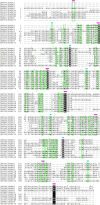Characteristics of the Kelch domain containing (KLHDC) subfamily and relationships with diseases
- PMID: 39887712
- PMCID: PMC12035522
- DOI: 10.1002/1873-3468.15108
Characteristics of the Kelch domain containing (KLHDC) subfamily and relationships with diseases
Abstract
The Kelch protein superfamily is an evolutionary conserved family containing 63 alternate protein coding members. The superfamily is split into three subfamilies: Kelch like (KLHL), Kelch-repeat and bric-a-bracs (BTB) domain containing (KBTBD) and Kelch domain containing protein (KLHDC). The KLHDC subfamily is one of the smallest within the Kelch superfamily, containing 10 primary members. There is little known about the structures and functions of the subfamily; however, they are thought to be involved in several cellular and molecular processes. Recently, there have been significant structural and biochemical advances for KLHDC2, which has aided our understanding of other KLHDC family members. Furthermore, small molecules directly targeting KLHDC2 have been identified, which act as tools for targeted protein degradation. This review utilises this information, in conjunction with a thorough exploration of the structural aspects and potential biological functions to summarise the relationship between KLHDCs and human disease.
Keywords: KLHDC; Kelch family; protein degradation; protein function.
© 2025 The Author(s). FEBS Letters published by John Wiley & Sons Ltd on behalf of Federation of European Biochemical Societies.
Figures





References
-
- Adams J, Kelso R and Cooley L (2000) The Kelch repeat superfamily of proteins: propellers of cell function. Trends Cell Biol 10, 17–24. - PubMed
-
- Shi X, Xiang S, Cao J, Zhu H, Yang B, He Q and Ying M (2019) Kelch‐like proteins: physiological functions and relationships with diseases. Pharmacol Res 148, 104404. - PubMed
Publication types
MeSH terms
Grants and funding
LinkOut - more resources
Full Text Sources

